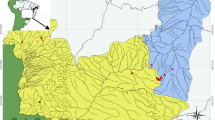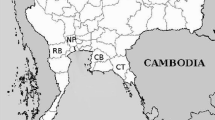Abstract
Forty nine characters were measured in each of 76 male and 200 female Daphnia including specimens from all eleven taxa described from the genus in Australia, except D. jollyi. Separate multivariate analyses (cluster, principal components and discriminant) of males and females each revealed only five morphological groups in the genus corresponding to the species D. occidentalis, D. lumholtzi, D. cephalata, D. nivalis, and a conglomerate of all other taxa described from the D. carinata complex, D. carinata (sensu lato). Interpretation of the male results was straightforward, but that for females was not because of the occurrence of an environmentally induced seasonal change in morphology (cyclomorphosis) in females. Log transformations of the female data successfully isolated the effects of cyclomorphosis. The seasonal morphs formed two groups which were further differentiated into taxonomic groups.
Similar content being viewed by others
References
Bayly, I. A. E. & W. D. Williams, 1973. Inland waters and their ecology. Longman. Australia and Hong Kong. 316 pp.
Benzie, J. A. H., 1985. The systematics and population structure of the Daphnia carinata complex in Australia. PhD Thesis. Australian National University, Canberra. 210 pp.
Benzie, J. A. H., 1986. Daphnia occidentalis new species (Cladocera, Daphniidae) from Western Australia: new evidence on the evolution of the North American D. ambigua — D. middendorffiana group. J. Crust. Biol. 6: 232–245.
Benzie, J. A. H., 1988. The systematics of Australian Daphnia (Cladocera: Daphniidae). Electrophoretic analyses of the Daphnia carinata complex. Hydrobiologia 166: 183–197.
Dodson, S. I., 1981. Morphological variation of D. pulex Leydig (Crustacea: Cladocera) and related species from North America. Hydrobiologia 83: 101–114.
Edwards, C., 1980. The anatomy of Daphnia mandibles. Trans. Am. Microsc. Soc. 99: 2–24.
Gower, J. C., 1971. A general coefficient of similarity and some of its properties. Biometrics 27: 857–874.
Grant, J. W. G. & I. A. E. Bayly, 1981. Predator induction of crests in morphs of the D. carinata King complex. Limnol. Oceanogr. 26: 201–218.
Hebert, P. D. N., 1977. A revision of the taxonomy of the genus Daphnia (Crustacea: Daphnidae) in south-eastern Australia. Aust. J. Zool. 25: 371–398.
Hebert, P. D. N., 1978. The population biology of Daphnia (Crustacea, Daphnidae). Biol. Rev. 53: 387–426.
Hebert, P. D. N., 1983. Clonal diversity in cladoceran populations. In ‘Population Biology: Retrospect and Prospect’. C. E. King & P. S. Dawson (eds). Columbia University Press, New York.
Hebert, P. D. N., 1985. Interspecific hybridization between cyclic parthenogens. Evolution 39: 216–220:
Hebert, P. D. N. & D. B. McWalter, 1983. Cuticular pigmentation in arctic Daphnia: adaptive diversification of asexual lineages? Am. Nat. 122: 286–291.
King, R. L., 1853a. On some species of Daphnidea found in New South Wales. Proc. R. Soc. Van Diemen's Land 2: 243–253.
King, R. L., 1853b. On Australian entomostracans — in continuation. Proc. R. Soc. Van Dieman's Land 2: 253–263.
Mitchell, B. D., 1978. Cyclomorphosis in Daphnia carinata King (Crustacea: Cladocera) from two adjacent sewage lagoons in South Australia. Aust. J. mar. freshwat. Res. 29: 565–576.
Nie, N. H., C. H. Hull, J. G. Jenkins, K. Steinbrenner & D. H. Brent, 1975. Statistical Package for the Social Sciences 2nd edition. McGraw Hill Publishing Company. New York.
Petkovski, T. K., 1973. Zur Cladoceren-fauna Australiens. I. Daphniidae und Chydoridae. Acta Mus. maced. Sci. nat. 13: 133–157.
Ross, D. (ed.), 1983. Taxon users manual. Edition P3B CSIRO Net Manual No. 6. CSIRO Division of Computing Research, Canberra. 190 pp.
Sars, G. O., 1885. On some Australian Cladocera, raised from dried mud. Videnskabs. Forh. No. 8. 46 pp. 8 plates.
Sars, G. O., 1914. Daphnia carinata King and its remarkable varieties. Arch. Math. Nat. B. 34: 1–14.
Schoedler, E., 1877. Zur Naturgeschichte der Daphniden. Dorotheen Stoottisch realschule. Berlin. Beilage zu dem Programm No. 77: 1–24.
Sneath, P. H. A. & R. R. Sokal, 1973. Numerical Taxonomy. W. H. Freeman and Co., San Francisco. 573 pp.
Schwartz, S. S., D. J. Innes & P. D. N. Hebert, 1985. Morphological separation of Daphnia pulex and Daphnia obtusa in North America. Limnol. Oceanogr. 30: 189–197.
Williams, W. T. (ed.), 1976. Pattern analysis in agricultural science. CSIRO-Elsevier, Melbourne. 331 pp.
Wolf, H. G. & Morth, M. A., 1986. Inter-specific hybridization underlies phenotypic variability in Daphnia populations. Oecologia (Berlin) 68: 507–511.
Author information
Authors and Affiliations
Rights and permissions
About this article
Cite this article
Benzie, J.A.H. The systematics of Australian Daphnia (Cladocera: Daphniidae). Multivariate morphometrics. Hydrobiologia 166, 163–182 (1988). https://doi.org/10.1007/BF00028633
Received:
Revised:
Accepted:
Issue Date:
DOI: https://doi.org/10.1007/BF00028633




